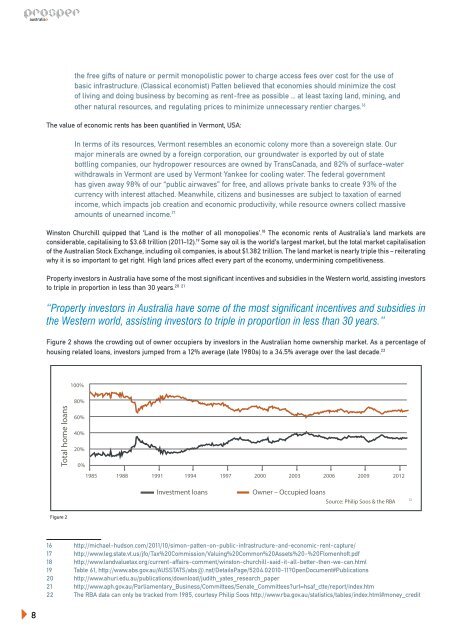TOTAL RESOURCE RENTS OF AUSTRALIA
Create successful ePaper yourself
Turn your PDF publications into a flip-book with our unique Google optimized e-Paper software.
the free gifts of nature or permit monopolistic power to charge access fees over cost for the use of<br />
basic infrastructure. (Classical economist) Patten believed that economies should minimize the cost<br />
of living and doing business by becoming as rent-free as possible ... at least taxing land, mining, and<br />
other natural resources, and regulating prices to minimize unnecessary rentier charges. 16<br />
The value of economic rents has been quantified in Vermont, USA:<br />
In terms of its resources, Vermont resembles an economic colony more than a sovereign state. Our<br />
major minerals are owned by a foreign corporation, our groundwater is exported by out of state<br />
bottling companies, our hydropower resources are owned by TransCanada, and 82% of surface-water<br />
withdrawals in Vermont are used by Vermont Yankee for cooling water. The federal government<br />
has given away 98% of our “public airwaves” for free, and allows private banks to create 93% of the<br />
currency with interest attached. Meanwhile, citizens and businesses are subject to taxation of earned<br />
income, which impacts job creation and economic productivity, while resource owners collect massive<br />
amounts of unearned income. 17<br />
Winston Churchill quipped that ‘Land is the mother of all monopolies’. 18 The economic rents of Australia’s land markets are<br />
considerable, capitalising to $3.68 trillion (2011–12). 19 Some say oil is the world’s largest market, but the total market capitalisation<br />
of the Australian Stock Exchange, including oil companies, is about $1.382 trillion. The land market is nearly triple this – reiterating<br />
why it is so important to get right. High land prices affect every part of the economy, undermining competitiveness.<br />
Property investors in Australia have some of the most significant incentives and subsidies in the Western world, assisting investors<br />
20 21<br />
to triple in proportion in less than 30 years.<br />
“Property investors in Australia have some of the most significant incentives and subsidies in<br />
the Western world, assisting investors to triple in proportion in less than 30 years.”<br />
Figure 2 shows the crowding out of owner occupiers by investors in the Australian home ownership market. As a percentage of<br />
housing related loans, investors jumped from a 12% average (late 1980s) to a 34.5% average over the last decade. 22<br />
100%<br />
80%<br />
Total home loans<br />
60%<br />
40%<br />
20%<br />
0%<br />
1985 1988 1991 1994 1997 2000 2003 2006 2009 2012<br />
Investment loans<br />
Owner – Occupied loans<br />
Source: Philip Soos & the RBA<br />
12<br />
Figure 2<br />
16 http://michael-hudson.com/2011/10/simon-patten-on-public-infrastructure-and-economic-rent-capture/<br />
17 http://www.leg.state.vt.us/jfo/Tax%20Commission/Valuing%20Common%20Assets%20-%20Flomenhoft.pdf<br />
18 http://www.landvaluetax.org/current-affairs-comment/winston-churchill-said-it-all-better-then-we-can.html<br />
19 Table 61, http://www.abs.gov.au/AUSSTATS/abs@.nsf/DetailsPage/5204.02010-11?OpenDocument#Publications<br />
20 http://www.ahuri.edu.au/publications/download/judith_yates_research_paper<br />
21 http://www.aph.gov.au/Parliamentary_Business/Committees/Senate_Committees?url=hsaf_ctte/report/index.htm<br />
22 The RBA data can only be tracked from 1985, courtesy Philip Soos http://www.rba.gov.au/statistics/tables/index.html#money_credit<br />
8



